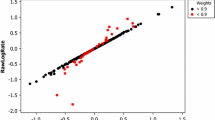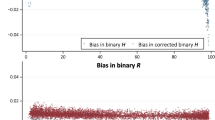Abstract
This short paper proposes a nonparametric method for accounting for the distribution of background characteristics when testing for segregation in empirical studies. It is shown and exemplified – using data on workplace segregation between immigrants and natives in Sweden – how the method can be applied to correct any measure of segregation for differences between groups in the distribution of covariates by means of simulation and how analytical results can be used when studying segregation by means of peer group exposure.
Similar content being viewed by others
Notes
Massey and Denton (1988) review 20 segregation indices. Recent work describing the characteristics of existing measures of segregation includes those by Flückiger and Silber (1999) and Hutchens (2004). Papers discussing multigroup segregation measures include those by Boisso et al. (1994) and Reardon and Firebaugh (2002). Some further discussion is provided in our working paper version Åslund and Skans (2005a).
A small number of previous studies have attempted to correct for covariates using more restrictive methods, e.g., Spriggs and Williams (1996), Bayer et al. (2004), Kalter (2000), and Reardon et al. (2000). In applied work parallel to this paper, Hellerstein and Neumark (2005) uses methods resting on logic similar to the one presented here. However, their presentation is more limited and, in contrast to this paper, relies entirely on simulations.
Throughout, we discuss ethnic workplace segregation, which was also the example provided by Carrington and Troske (1997).
In practice, this typically amounts to estimating a logit or probit for minority status and then using the estimates for assigning each person a predicted minority status.
The fully interacted model given by the nonparametric approach is arguably particularly important in studying dispersion over units. Consider a simple example where majority and minority are equally distributed over workplaces in two regions, and also over two skill groups, but where the fraction of high-skilled minority working in one region is larger than the corresponding fraction of the majority. A regression controlling only for region and skill will then explain nothing of the observed workplace segregation, whereas an interacted model will account for the unequal distribution across industry/region “cells.”
Note that the random number is continuous so equality occurs with probability zero.
As a matter of fact, neither does any other available measure of segregation.
Formally this is an approximation because it excludes oneself from both denominator and nominator for immigrants. Thus, an immigrant has expected exposure (M − 1/N − 1), whereas it is (M/N − 1) for a native. It is trivial in all but tiny sample sizes.
Note that with only one possible realization of X (i.e., with no covariates), Eq. 7 collapses to the fraction of immigrants in the population, as suggested in the introductory paragraph in this section.
For a more detailed description of ethnic segregation in the Swedish labor market, see Åslund and Skans (2005b).
See Åslund and Skans (2005a) for details on the data.
In their application to US workplace data, Carrington and Troske (1997) report levels of segregation that are relatively similar to ours. Their actual level of the Duncan (Gini) index is 0.504 (0.605); the unconditional expected level is 0.337 (0.488), which gives system segregation of 0.251 (0.344).
Indeed, basing the analysis on such a large number of covariates gives a conservative measure of segregation that probably understates the true level of ethnic segregation but makes the remaining amount more convincing.
See Åslund and Skans (2005b) for a list of the 26 regions available in the data.
References
Åslund O, Skans ON (2005a) Measuring conditional segregation: methods and empirical examples. Working paper 2005:12, IFAU, Uppsala
Åslund O, Skans ON (2005b) Will I see you at work? Ethnic workplace segregation in Sweden 1985–2002. Working paper 2005:24, IFAU, Uppsala
Bayer P, McMillan R, Rueben KS (2004) What drives residential segregation? New evidence using census microdata. J Urban Econ 56:514–535
Boisso D, Hayes K, Hirschberg J, Silber J (1994) Occupational segregation in the multidimensional Case. Decomposition and tests of significance. J Econom 61:161–171
Carrington WJ, Troske KR (1997) On measuring segregation in samples with small nits. J Bus Econ Stat 15(4):402–409
Echenique F, Fryer RG (2005) On the measurement of segregation. NBER working paper 11258
Echenique F, Fryer RG (2007) A measure of segregation based on social interactions. Q J Econ 122(2):441–485
Flückiger Y, Silber J (1999) The measurement of segregation in the labor force. Physica, Heidelberg
Hellerstein J, Neumark D (2005) Workplace segregation in the United States: race, ethnicity, and skill. NBER working paper 11599
Hutchens R (2004) One measure of segregation. Int Econ Rev 45(2):555–578
Kalter F (2000) Measuring segregation and controlling for independent variables. Arbeitspapiere Nr 19, 2000, Mannheimer Zentrum fur Europäische Sozialforschung
Massey DS, Denton NA (1988) The dimensions of residential segregation. Soc Forces 67(2):281–315
Reardon SF, Yun JT, Mcnulty Eitle T (2000) The changing structure of school segregation: measurement and evidence of multiracial metropolitan-area school segregation, 1989–1995. Demography 37(3):351–364
Reardon SF, Firebaugh G (2002) Measures of multigroup segregation. In: Stolzenberg RM (ed) Sociological methodology 32, 2002. Blackwell, Boston, pp 33–67
Rosenbaum P, Rubin D (1983) The central role of the propensity score in observational studies for causal effects. Biometrica 70:41–55
Spriggs WE, Williams RM (1996) A logit decomposition analysis of occupational segregation: results for the 1970s and 1980s. Rev Econ Stat 78(2):348–355
Winship C (1977) A revaluation of indexes of residential segregation. Soc Forces 55(4):1058–1066
Acknowledgements
We are grateful for comments from two anonymous referees, Per Johansson, Eva Mörk, Roope Uusitalo, seminar participants at the Institute for Labour Market Policy Evaluation, and Växjö University. The work is partly financed by a grant from the Swedish council for working life and social research (FAS). The order of the authors is according to the English alphabet and is not related to contribution.
Author information
Authors and Affiliations
Corresponding author
Additional information
Responsible editor: Klaus F. Zimmermann
Rights and permissions
About this article
Cite this article
Åslund, O., Nordström Skans, O. How to measure segregation conditional on the distribution of covariates. J Popul Econ 22, 971–981 (2009). https://doi.org/10.1007/s00148-008-0189-4
Received:
Accepted:
Published:
Issue Date:
DOI: https://doi.org/10.1007/s00148-008-0189-4




